This page may contain affiliate links, which means I will make a small commission for products purchased through my link.
These delicious, bright green Matcha Cookies are beautiful, delicious, and so festive! Made completely vegan and gluten-free, these crinkle cookies are perfect for holiday swaps or to celebrate any occasion with a matcha lover!
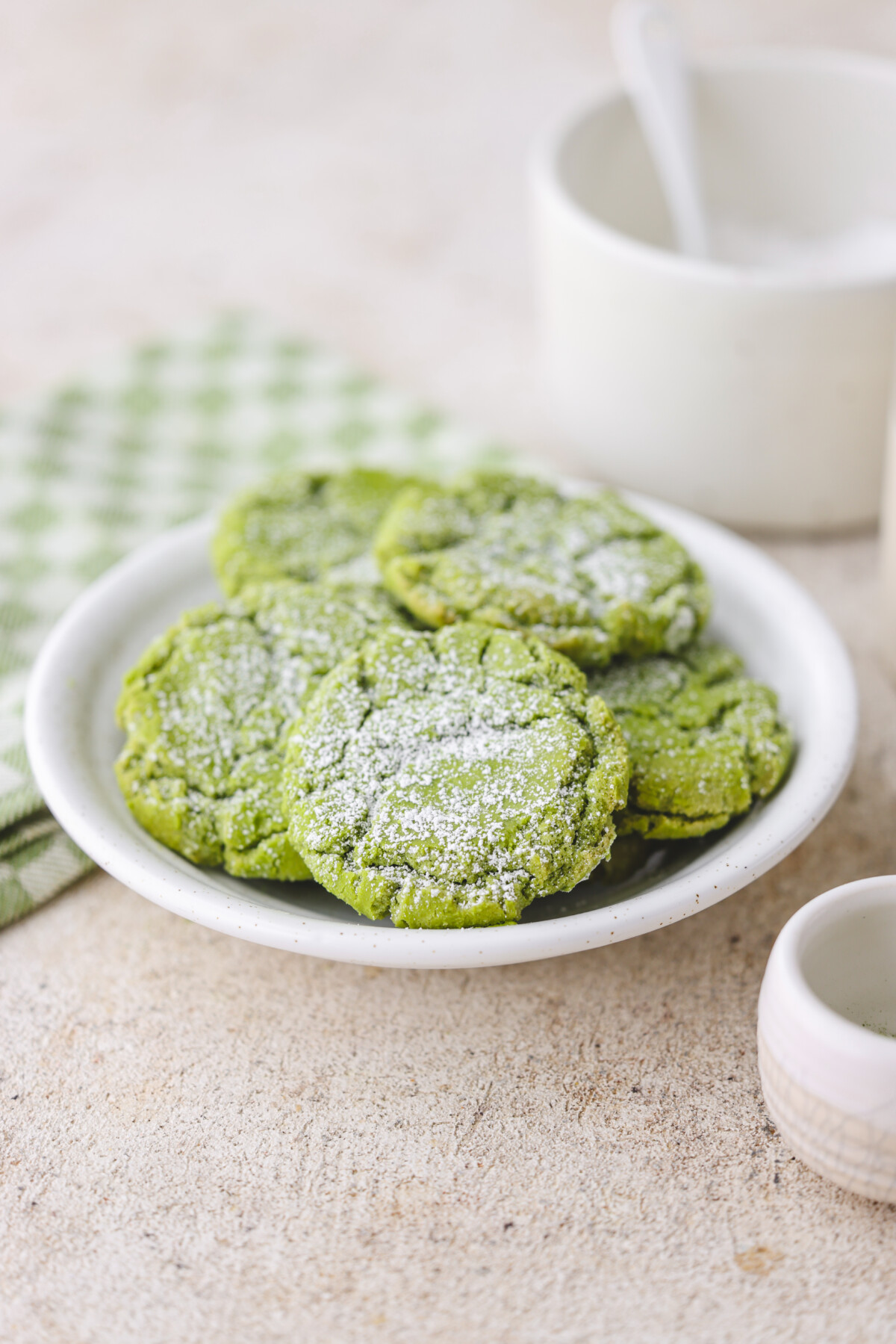
What are Crinkle Cookies?
Crinkle cookies get their name from their crackly surface. You get that look by rolling the dough in sugar before baking. This adds a bit of crunch and crackle to the surface of the cookies and adds that crinkly texture while the cookies bake.
Though you’ll be rolling these cookies in sugar, the matcha in the recipe adds a nice bitterness and earthiness that cuts down the sweetness for perfect balance. It also adds a beautiful green colour and the flavor pairs great with a glass of plant-based milk.
If you’re looking for more unique cookies to bring to a holiday cookie swap, try Butternut Squash Snickerdoodle Cookies, Strawberry Matcha Sugar Cookies, or Cranberry Orange Cashew Butter Cookies.
What Makes This Recipe Great
This matcha cookie recipe is basically all of the delicious flavors of matcha green tea, in cookie form! Even better, these crinkle cookies are vegan and gluten-free, but you’d really never know the difference!
Soft and chewy, and balanced, these are THE perfect treat for an afternoon tea, a cookie swap, or dessert. And if you feel like it, throw in some white chocolate chips or regular chocolate chips for an extra fun surprise in every bite!
Ingredient Notes
Here’s what you need to make these vegan and gluten-free crinkle cookies.
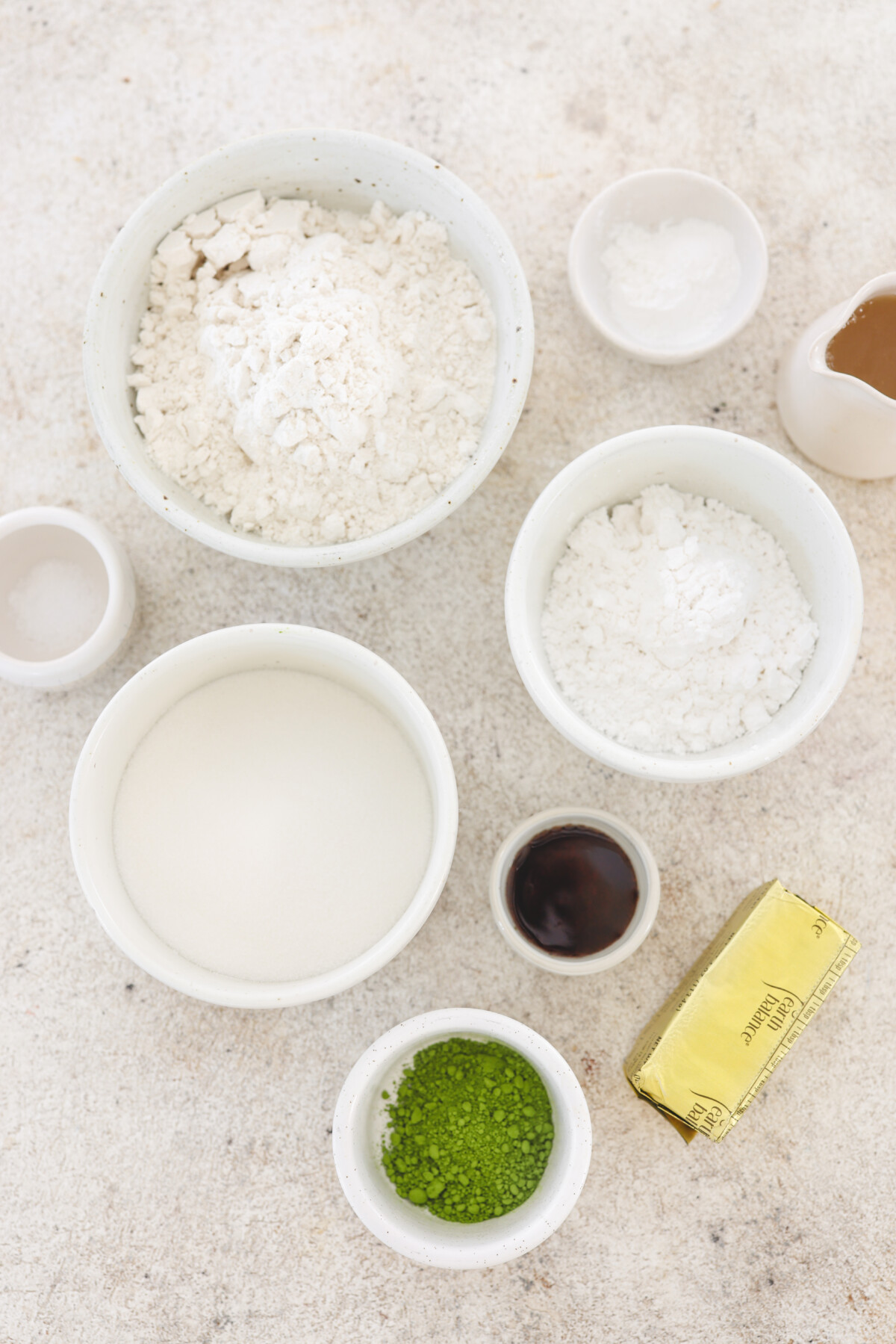
- Sugar: I use organic cane sugar for the dough and confectioner’s sugar for the coating. I don’t recommend using coconut sugar, brown sugar, or another sweetener, as it will affect the color of your pretty green cookies.
- Vegan Butter: It’s very important to use softened vegan butter, not vegan spreadable butter. Spread will not hold up and your cookies will fall apart. I recommend the Earth Balance brand.
- Aquafaba: This is the liquid you get when you drain chickpeas. It’s an excellent egg replacer in vegan baking recipes.
- Matcha: Be sure to use a flavorful and fresh ceremonial-grade matcha that you love the flavor of.
- Vanilla Bean Paste: You can also use pure vanilla extract.
- Gluten-Free All-Purpose Flour: I use Bob’s Red Mill Gluten-Free Measure-for-Measure Flour. Note that you can try using alternate flours if you like, but you may get different results with your cookies.
- Baking Powder
- Salt
Step-by-Step Instructions
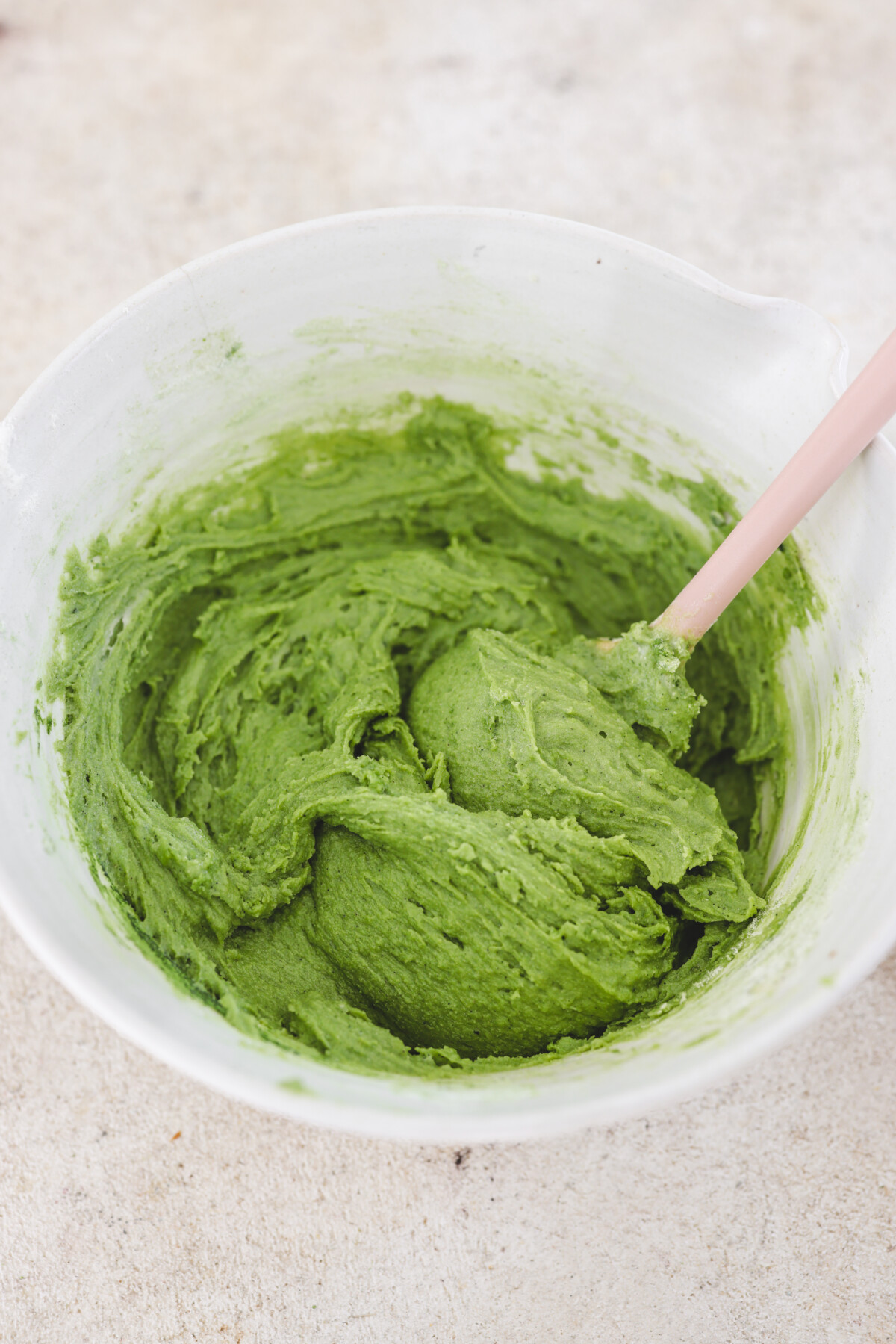
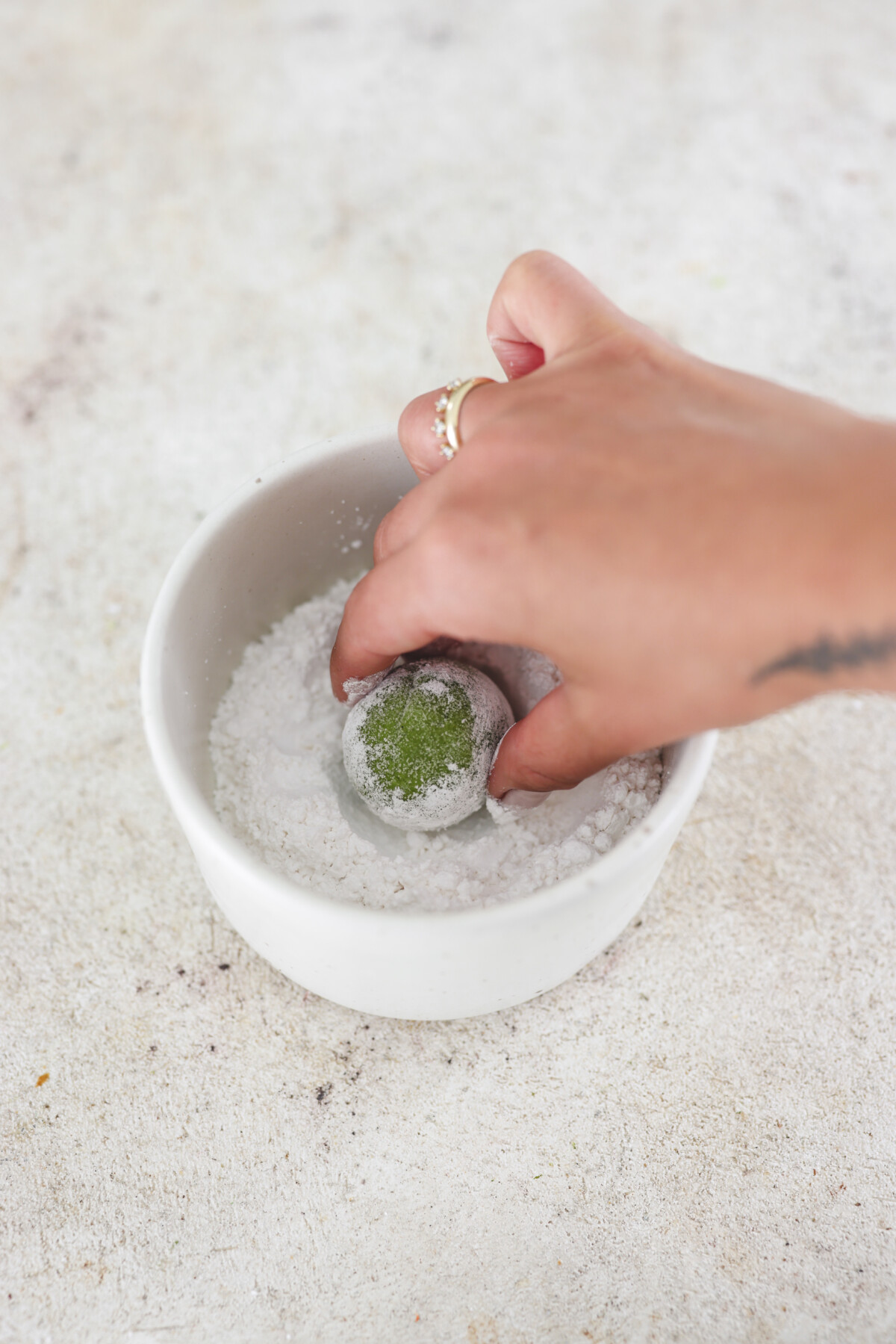
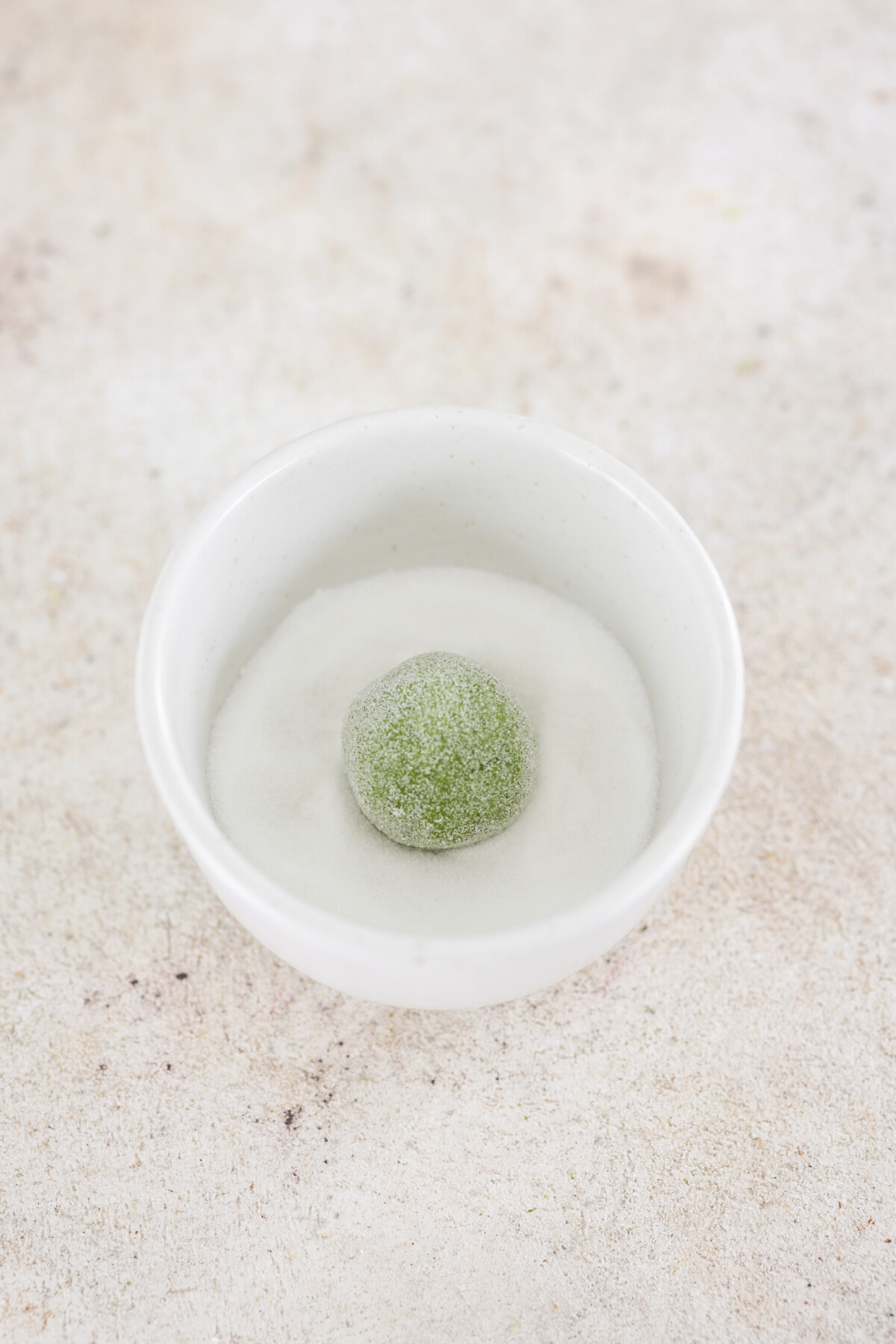
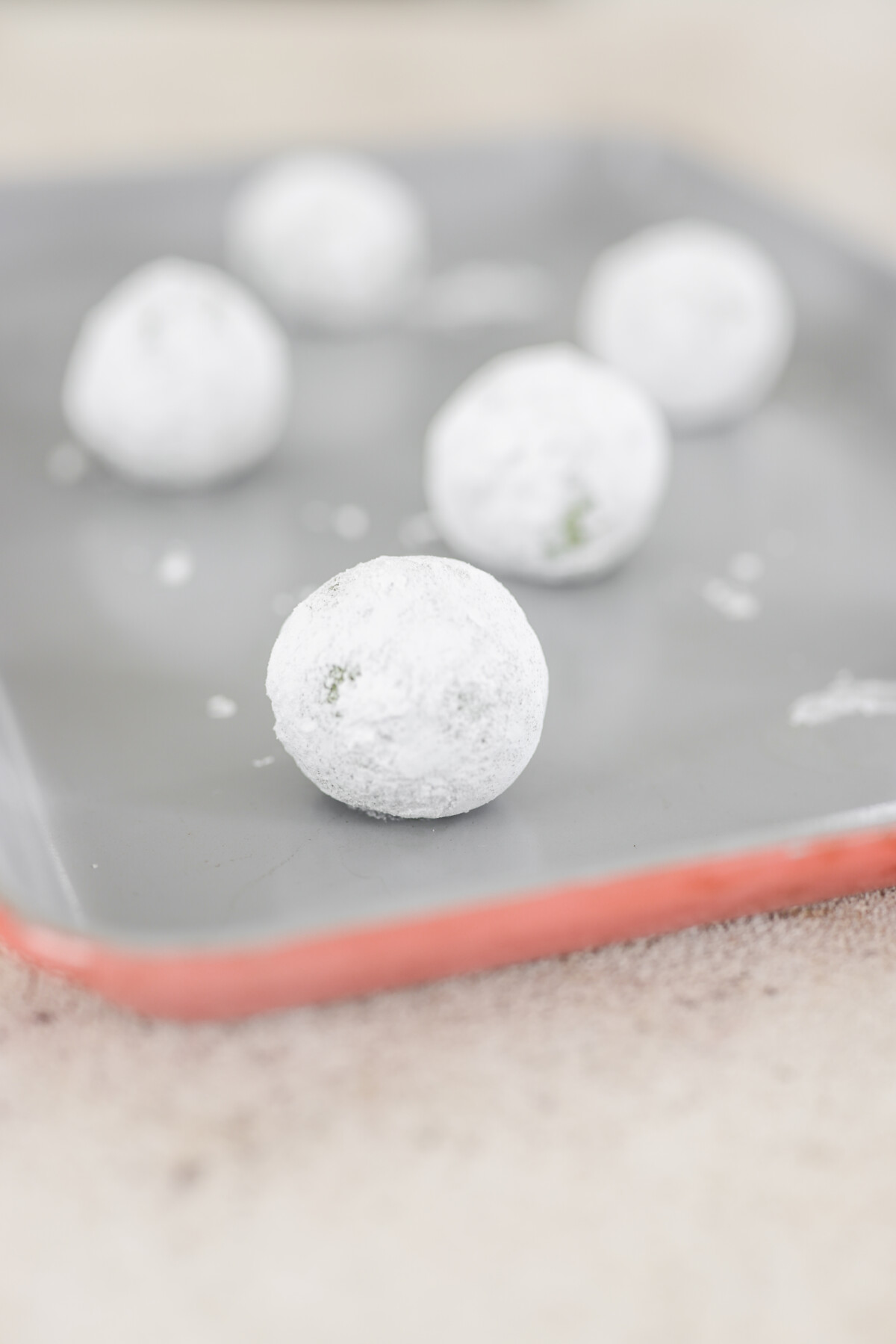
- To prepare your dough, start by whipping softened butter and sugar together in a mixing bowl until smooth.
- Quickly whip your aquafaba using a small whisk until nice and frothy, then add to the bowl along with vanilla. Using a spatula, stir together until incorporated. It’s okay if there is some chunkiness in the batter at this point.
- Next, add dry ingredients. Add flour, baking powder, and salt and stir again until a dough forms and no dry flour spots remain. Cover the bowl with an airtight seal and chill the dough in the fridge for at least 2 hours, or about 30 minutes in the freezer.
- When ready to bake, preheat your oven to 350F while you prepare the dough balls. Prepare a baking sheet (or two) with a nonstick baking mat or parchment paper.
- Have two bowls ready, one with powdered sugar and the other with granulated sugar. Using a cookie scoop, take a scoop of dough, and roll it quickly between your palms to create a ball. Cover the dough with granulated sugar followed by powdered sugar. Transfer the dough to your baking mat and repeat with the remaining dough, leaving 2-3″ between each cookie.
- You can bake the cookies as is, or you can flatten them with the bottom of a drinking glass or bowl to about an inch in thickness. Personally, I think the cookies turn out in a more uniform shape when flattened down but you can also bake them as balls if you prefer a puffier cookie. Bake the cookies for 8-10 minutes, until the edges have crisped up. They will continue to cook as they cool on the sheet! Repeat until all cookies are baked.
- If the sugar coating melts away after baking, you can dust your cookies with a touch of powdered sugar to finish.
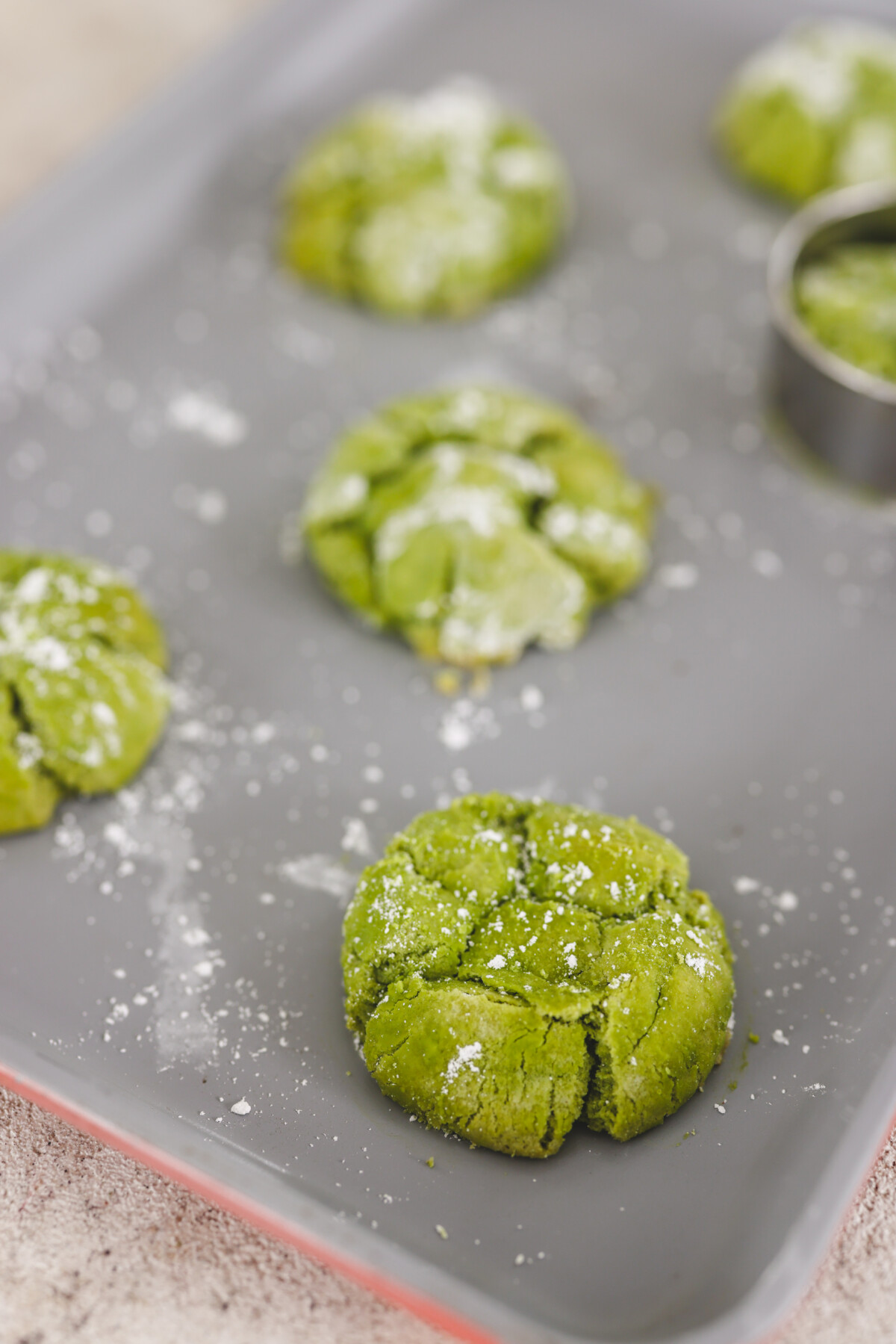
Expert Tips
- Chilling the Dough: It’s very important to chill your dough before baking for at least 3 hours, preferably overnight, in an airtight container. The butter in the dough must be very cold when you bake the cookies. If it’s not chilled, the dough will spread like crazy in the oven!
- Baking Prep: Before baking, line your baking sheets with parchment or a silicone mat. Then use a cookie scoop to divide the chilled dough between baking sheets.
- Press the Dough: I recommend pressing each cookie down with the bottom of a glass slightly. Otherwise, the cookies tend to poof and crack on top. But if you prefer a taller, chewier cookie, you can bake them as balls.
- Shape after Baking: Immediately after baking, while the cookies are still hot on the baking sheet, use a ring mold or upside-down glass to shape them into perfect circles if you’d like. Then, let them cool completely to room temperature.
What Kind of Matcha is Used in Baking?
If you’re wondering whether you should bake with culinary or ceremonial-grade matcha, it’s important to know the difference between the two. It really comes down to price and quality. Culinary-grade matcha is harvested during the second harvest of the year. Ceremonial-grade matcha is from the premium, first harvest.
You’ll also likely notice a big difference in flavor and color between the two varieties. The culinary powder can sometimes have a dull yellow or brown color. On the other hand, ceremonial grade matcha has a rich, vibrant, and deep green color. Culinary-grade matcha often has a more bitter flavor. Some even have a bit of a fishy flavor.
For drinking, I strongly recommend using ceremonial grade. It’s higher in nutrients and has the best flavor and color. And while the name “culinary” may suggest that it is better for cooking, the color and flavor are much more muted, so I still recommend using ceremonial-grade matcha for these crinkle cookies, Matcha Checkerboard Cookies, or Matcha Butter Mochi Cake.
And when you’re buying matcha, it’s very important to check the label. Matcha powder should contain only one ingredient: matcha. Avoid anything labeled “matcha” that contains added cornstarch or unnecessary ingredients like sweeteners. To learn everything you need to know about matcha, check out How To Make Matcha at Home & Matcha 101.
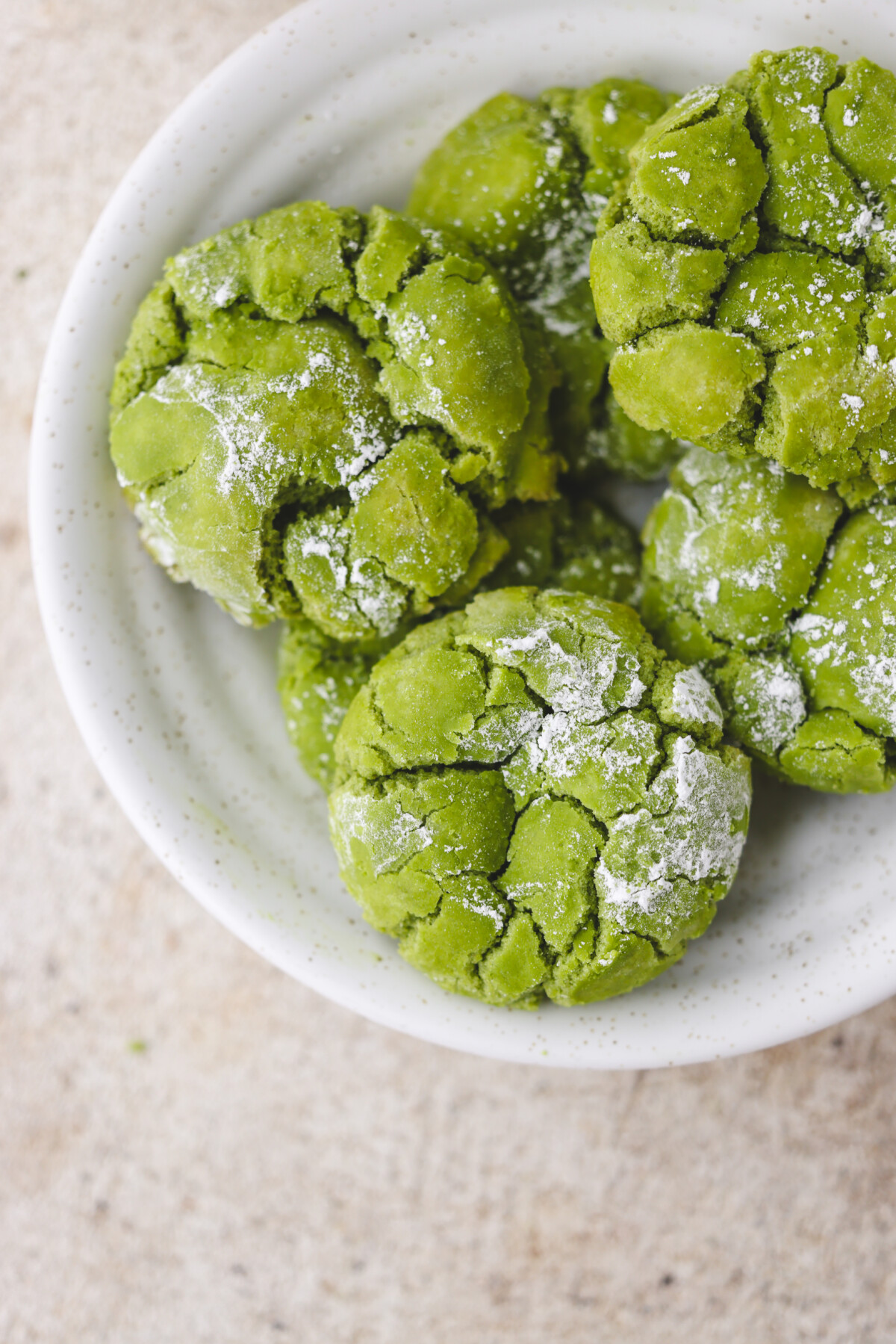
Do Matcha Cookies Contain Caffeine?
Matcha cookies do have a small amount of caffeine and a matcha latte can contain just as much caffeine as coffee. However, those who are sensitive to the caffeine in coffee may not necessarily be as sensitive to the caffeine in matcha.
On average, an 8-oz. cup of matcha can contain about 25-75mg of caffeine. For comparison, 8 ounces of coffee contains about 95 mg of caffeine on average. However, the caffeine content of matcha tends to be much more tolerable than in coffee. This is because of L-theanine in matcha, which results in a slower, more sustained release of energy with no sudden crash.
For this reason, Buddhist monk Eisai said that matcha offers drinkers a “calm alertness”, rather than the jumpiness of caffeine from coffee. In addition to L-theanine, matcha contains EGCG (epigallocatechin gallate) a potent catechin, chlorophyll, and more.
In addition, when you consume caffeine with fats, sugars, or carbohydrates (any food really), the caffeine has less of a jittery effect.
Storage Tips
- Store fully-cooled matcha cookies in an airtight container in a cool dark place. The matcha will oxidize and cookies will turn white or grey if they’re exposed to the sun. You can also use a metal cookie tin (whatever keeps the sun out).
- To freeze, store in a freezer-safe container for up to 6 months.
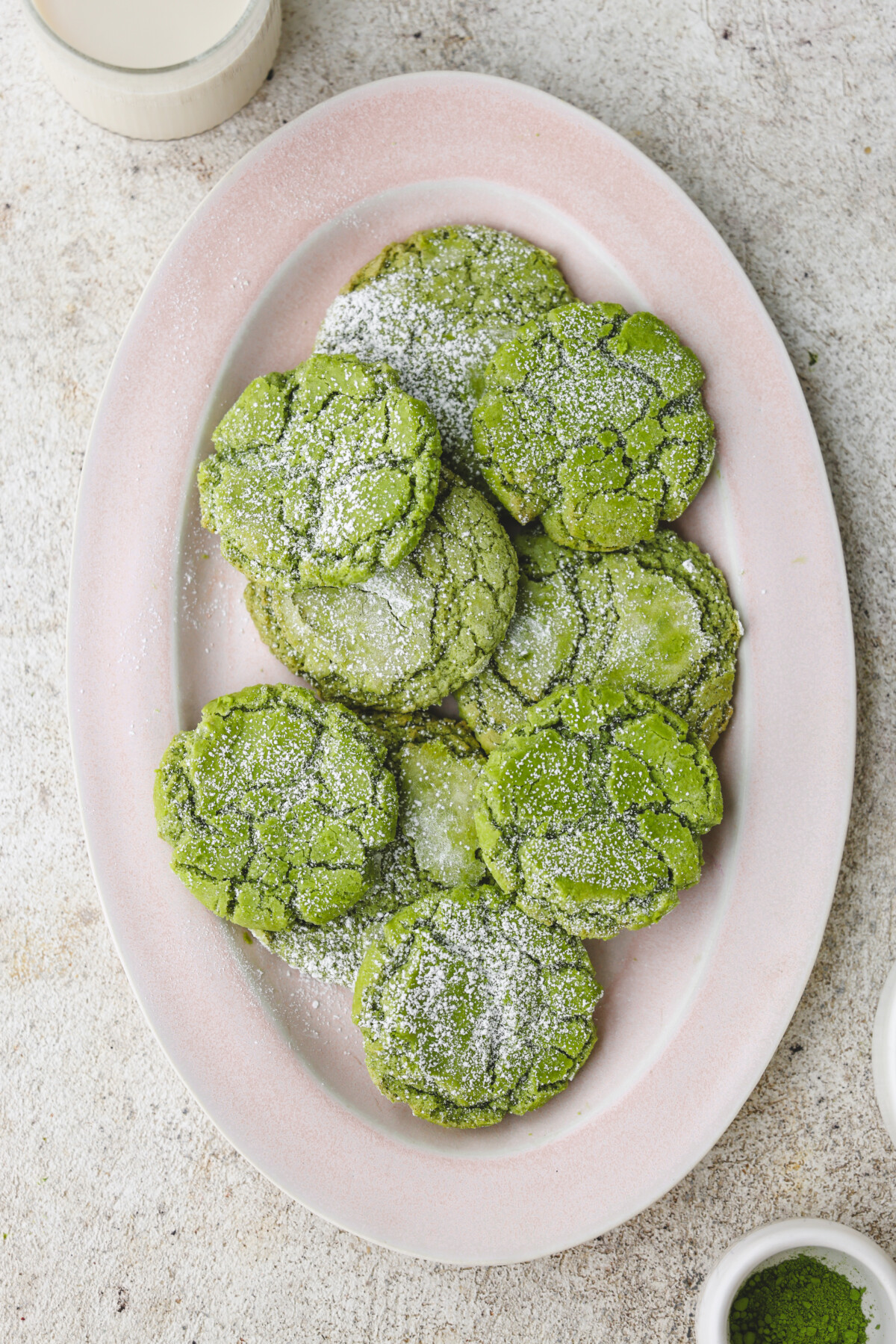
Recipe FAQs
It’s possible that you overbaked your cookies. Prolonged exposure to heat will cause the enzymes in matcha to turn brown. When storing, your cookies may turn color if stored in a place that gets a lot of sunlight.
Matcha is very easy to use in baked goods and adds a natural, vibrant green color, as well as an earthy flavor. It pairs very well with vanilla, which makes it great for cookies!
Yes! You can use the same matcha powder that you drink for baking matcha cookies. In fact, the better the quality of the matcha, the deeper green, and more flavorful the cookie.
More Matcha Recipes to Love
Vegan Matcha Rice Krispie Treat
3-Ingredient Matcha Dusted Chocolate Almonds
If you make these vegan matcha cookies, be sure to let me know what you think with a comment below!
Easy Vegan Matcha Crinkle Cookies

Equipment
- Nonstick Baking Mat or use parchment paper
Ingredients
- 1 cup granulated sugar I use organic cane sugar
- 1/3 cup vegan butter room temp, softened
- 1/4 cup aquafaba (chickpea brine)
- 1 tsp vanilla bean paste or vanilla extract
- 1 1/2 cups gluten free flour I used Bob's Red Mill 1-1
- 2 tbsp matcha powder ceremonial grade
- 1 tsp baking powder
- 1/4 tsp salt
Sugar Coating
- 1/4 cup powdered sugar
- 1/4 cup granulated sugar
Instructions
- To prepare your dough, start by whipping softened butter and sugar together in a mixing bowl until smooth.
- Quickly whip your aquafaba using a small whisk until nice and frothy, then add to the bowl along with vanilla. Using a spatula, stir together until incorporated. It's okay if there is some chunkyness in the batter at this point.
- Next add dry ingredients. Add flour, baking powder and salt and stir again until a dough forms and no dry flour spots remain. Cover the bowl with an airtight seal and chill the dough in the fridge for at least 2 hours, or about 30 minutes in the freezer.
- When ready to bake, preheat your oven to 350F while you prepare the dough balls. Prepare a baking sheet (or two) with a nonstick baking mat or parchment paper.
- Have two bowls ready, one with powdered sugar and the other with granulated sugar. Using a cookie scoop, take a scoop of dough, roll it quickly between your palms to create a ball. Cover the dough with granulated sugar followed by powdered sugar. Transfer the dough to your baking mat and repeat with remaining dough, leaving 2-3" between each cookie.
- You can bake the cookies as is, or you can flatten with the bottom of a drinking glass or bowl to about an inch in thickness. Personally, I think the cookies turn out in a more uniform shape when flattened down but you can also bake them as balls if you prefer a puffier cookie. Bake the cookies for 8-10 minutes, until edges have crisped up. They will continue to cook as they cool on the sheet! Repeat until all cookies are baked.
- If the sugar coating melts away after baking, you can dust your cookies with a touch of powdered sugar to finish.
Notes
Expert Tips
- Chilling the Dough: It’s very important to chill your dough before baking for at least 3 hours, preferably overnight, in an airtight container. The butter in the dough must be very cold when you bake the cookies. If it’s not chilled, the dough will spread like crazy in the oven!
- Baking Prep: Before baking, line your baking sheets with parchment or a silicone mat. Then use a cookie scoop to divide the chilled dough between baking sheets.
- Press the Dough: I recommend pressing each cookie down with the bottom of a glass slightly. Otherwise, the cookies tend to poof and crack on top. But if you prefer a taller, chewier cookie, you can bake them as balls.
- Shape after Baking: Immediately after baking, while the cookies are still hot on the baking sheet, use a ring mold or upside-down glass to shape them into perfect circles if you’d like. Then, let them cool completely to room temperature.
Storage Tips
- Store fully-cooled matcha cookies in an airtight container in a cool dark place. The matcha will oxidize and cookies will turn white or grey if they’re exposed to the sun. You can also use a metal cookie tin (whatever keeps the sun out).
- To freeze, store in a freezer-safe container for up to 6 months.
Nutrition information is automatically calculated, so should only be used as an approximation.

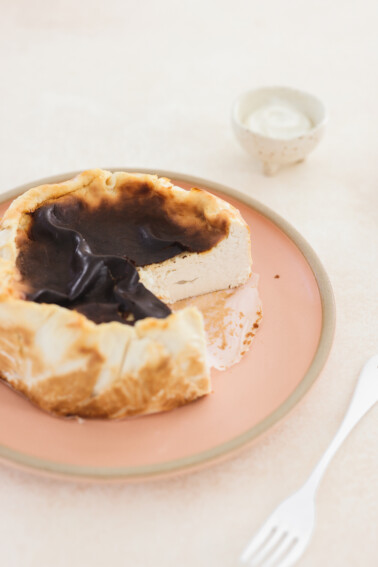
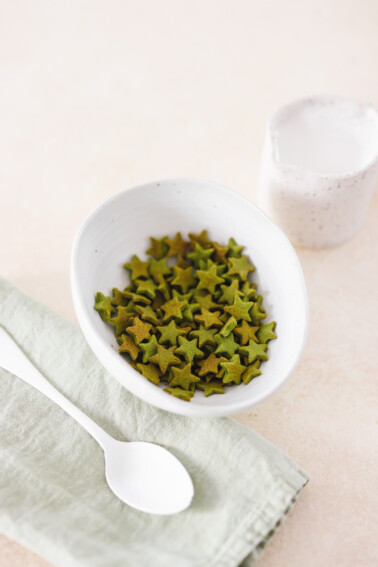
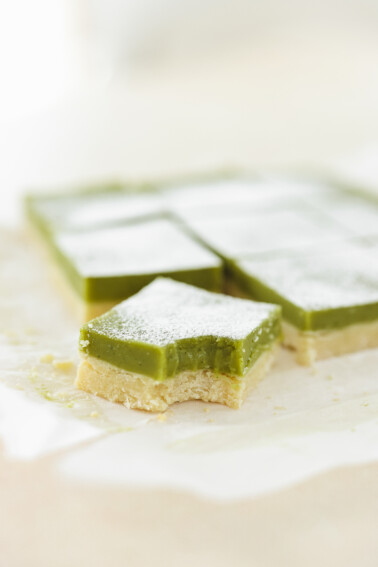
2 Comments